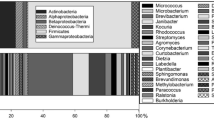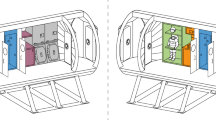Abstract
One of the main tasks of NASA's planetary protection program is to prevent the forward contamination of extraterrestrial environments with Earth life, and in turn preserve other planets and the integrity of future life detection missions. Despite information regarding bacterial diversity in NASA's clean rooms, little is known about the presence of Archaea. Archaeal community analysis of spacecraft-associated surfaces is important, as they are considered by some to represent terrestrial life most capable of surviving on Mars. The first insights into the archaeal diversity of clean rooms where spacecraft assembled are attempted. Nucleic acid sequences clustering with uncultivable Archaea within the Eury- and Crenarchaeota were retrieved from 8 of 26 samples collected from several spacecraft assembly clean rooms. Due to their potential capability to survive and proliferate in Martian conditions, screening for Archaea on spacecraft surfaces and instruments that are associated with future life detection missions may be necessary.
Similar content being viewed by others
Log in or create a free account to read this content
Gain free access to this article, as well as selected content from this journal and more on nature.com
or
References
Bintrim SB, Donohue TJ, Handelsman J, Roberts GP, Goodman RM . (1997). Molecular phylogeny of Archaea from soil. Proc Natl Acad Sci USA 94: 277–282.
DeLong EF, Wu KY, Prezelin BB, Jovine RV . (1994). High abundance of Archaea in Antarctic marine picoplankton. Nature 371: 695–697.
Fisk MR, Giovannoni SJ . (1999). Sources of nutrients and energy for a deep biosphere on Mars. J Geophys Res 104: 11805–11816.
Herkenhoff KE, Squyres SW, Arvidson R, Bass DS, Bell JF, Bertelsen P et al. (2004). Evidence from opportunity's microscopic imager for water on Meridiani Planum. Science 306: 1727–1730.
Kato MT, Field JA, Lettinga G . (1997). Anaerobe tolerance to oxygen and the potentials of anaerobic and aerobic cocultures for wastewater treatment. Braz J Chem Eng 14 (Available from:〈http://www.scielo.br/scielo.php?script=sci_arttext&pid=S0104-66321997000400015&lng=en&nrm=iso〉).
Konneke M, Bernhard AE, de la Torre JR, Walker CB, Waterbury JB, Stahl DA . (2005). Isolation of an autotrophic ammonia-oxidizing marine archaeon. Nature 437: 543–546.
Krasnopolsky VA . (2006). Some problems related to the origin of methane on Mars. Icarus 180: 359–367.
La Duc MT, Dekas AE, Osman S, Moissl C, Newcombe D, Venkateswaran K . (2007). Isolation and characterization of bacteria capable of tolerating the extreme conditions of clean-room environments. Appl Environ Microbiol 73: 2600–2611.
Laloui-Carpentier W, Li T, Vigneron V, Mazéas L, Bouchez T . (2006). Methanogenic diversity and activity in municipal solid waste landfill leachates. Antonie Van Leeuwenhoek 89: 423–434.
Moissl C, La Duc MT, Osman S, Dekas AE, Venkateswaran K . (2007). Molecular bacterial community analysis of clean rooms where spacecraft are assembled. FEMS Microbiol Ecol 61: 509–521.
NASA (2005). Planetary Protection Provisions for Robotic Extraterrestrial Missions. NPR 8020.12C, April 2005. National Aeronautics and Space Administration: Washington, DC.
NASA-KSC (1999). Launch Site Requirement Planning Group, Facilities Handbook of Payload Hazardous Servicing Facility (PHSF), K-STSM-14.1.15 rev D. Edited by NASA-KSC: KSC: Cape Canaveral, FL.
Ochsenreiter T, Selezi D, Quaiser A, Bonch-Osmolovskaya L, Schleper C . (2003). Diversity and abundance of Crenarchaeota in terrestrial habitats studied by 16S RNA surveys and real time PCR. Environ Microbiol 5: 787–797.
Olsen GJ . (1994). Microbial ecology. Archaea, Archaea, everywhere. Nature 371: 657–658.
Rummel JD . (1989). Planetary protection policy overview and application to future missions. Adv Space Res 9: 181–184.
Schouten S, Hopmans EC, Pancost RD, Damste JS . (2000). Widespread occurrence of structurally diverse tetraether membrane lipids: evidence for the ubiquitous presence of low-temperature relatives of hyperthermophiles. Proc Natl Acad Sci USA 97: 14421–14426.
Simon HM, Jahn CE, Bergerud LT, Sliwinski MK, Weimer PJ, Willis DK et al. (2005). Cultivation of mesophilic soil crenarchaeotes in enrichment cultures from plant roots. Appl Environ Microbiol 71: 4751–4760.
Takai K, Moser DP, DeFlaun M, Onstott TC, Fredrickson JK . (2001). Archaeal diversity in waters from deep South African gold mines. Appl Environ Microbiol 67: 5750–5760.
Weiss BP, Yung YL, Nealson KH . (2000). Atmospheric energy for subsurface life on Mars? Proc Natl Acad Sci USA 97: 1395–1399.
Wu XL, Friedrich MW, Conrad R . (2006). Diversity and ubiquity of thermophilic methanogenic archaea in temperate anoxic soils. Environ Microbiol 8: 394–404.
Acknowledgements
This research was carried out at JPL/Caltech under a contract with NASA and funded by Mars Sample Return Mission program as well as by NRA ROSS 2005. We thank Jerome Smith and Anne Dekas (JPL), Judith Allton, Karen McNamara, and Carlton Allen (JSC) for helping to sample various locations and Shariff Osman for critically reading this manuscript. We acknowledge John Rummel, NASA Planetary Protection Officer for constant encouragements and Jason Kastner for facilitating various lab facilities.
Author information
Authors and Affiliations
Corresponding author
Additional information
Supplementary Information accompanies the paper on The ISME Journal website (http://www.nature.com/ismej)
Supplementary information
Rights and permissions
About this article
Cite this article
Moissl, C., Bruckner, J. & Venkateswaran, K. Archaeal diversity analysis of spacecraft assembly clean rooms. ISME J 2, 115–119 (2008). https://doi.org/10.1038/ismej.2007.98
Received:
Accepted:
Published:
Issue date:
DOI: https://doi.org/10.1038/ismej.2007.98
Keywords
This article is cited by
-
Microscopic Characterization of Biological and Inert Particles Associated with Spacecraft Assembly Cleanroom
Scientific Reports (2019)
-
Advanced Curation of Astromaterials for Planetary Science
Space Science Reviews (2019)
-
Human age and skin physiology shape diversity and abundance of Archaea on skin
Scientific Reports (2017)
-
Microbial succession in an inflated lunar/Mars analog habitat during a 30-day human occupation
Microbiome (2016)
-
A viability-linked metagenomic analysis of cleanroom environments: eukarya, prokaryotes, and viruses
Microbiome (2015)



